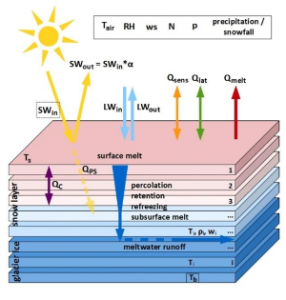
COSIPY is based on COSIMA, a ‘COupled Snowpack and Ice surface energy and MAss balance model’, translating the code into Python, and developing further the initial concepts. It combines a surface energy balance (SEB) with a multi-layer subsurface snow and ice model to compute the glacier mass balance (MB). The calculated surface melt water serves as input for the subsurface model. The two models are directly coupled in order to account for melt water percolation, retention and refreezing within the snow pack under consideration of latent heat release and resulting subsurface melt as well as the effects on subsurface temperature, snow density and ground heat flux. All subsurface
processes are resolved in a vertical layer structure. COSIPY consists of several modules for solving the heat equation, calculating percolation and refreezing and calculating densification. The modular model setup allows replacing single parameterizations. COSIPY computes the MB at an hourly time step from the sum of
accumulation by solid precipitation, deposition and refreezing of percolating melt water in the snow pack, and ablation by melt and sublimation. Forcing parameters are incoming shortwave radiation (W m-2), air temperature (K, 2 m), relative humidity (%, 2 m), air pressure (hPa), wind speed (m s-1, 2 m), all-phase precipitation (mm) and cloud cover fraction.
Download
Core developers
- Anselm Arndt
- Emily Collier
- Tobias Sauter
References
Sauter T, Arndt A and Schneider C (2020) COSIPY v1.3 – an open-source coupled snowpack and ice surface energy and mass balance model. Geoscientific Model Development 13(11), 5645–5662.
doi:https://doi.org/10.5194/gmd-13-5645-2020
Huintjes, E., Loibl, D., Lehmkuhl, F., Schneider, C., 2016. A modelling approach to reconstruct Little Ice Age climate from remote-sensing glacier observations in southeastern Tibet. Annals of Glaciology 57, 359–370. doi:10.3189/2016AoG71A025
Huintjes, E., Neckel, N., Hochschild, V., Schneider, C., 2015. Surface energy and mass balance at Purogangri ice cap, central Tibetan Plateau, 2001–2011. Journal of Glaciology 61, 1048–1060. doi:10.3189/2015JoG15J056
Huintjes, E., Sauter, T., Schröter, B., Maussion, F., Yang, W., Kropáček, J., Buchroithner, M., Scherer, D., Kang, S., Schneider, C., 2015. Evaluation of a Coupled Snow and Energy Balance Model for Zhadang Glacier, Tibetan Plateau, Using Glaciological Measurements and Time-Lapse Photography. Arctic, Antarctic, and Alpine Research 47, 573–590. doi:10.1657/AAAR0014-073


